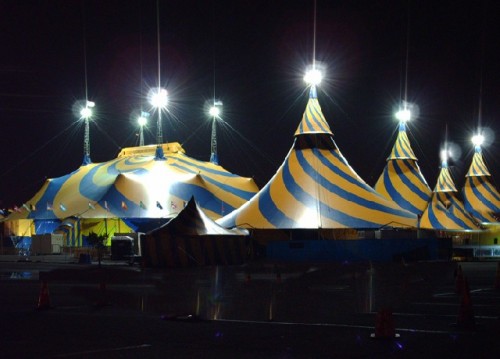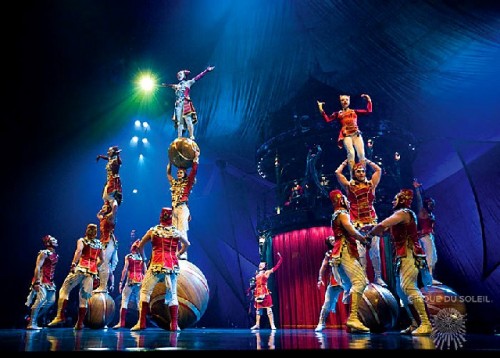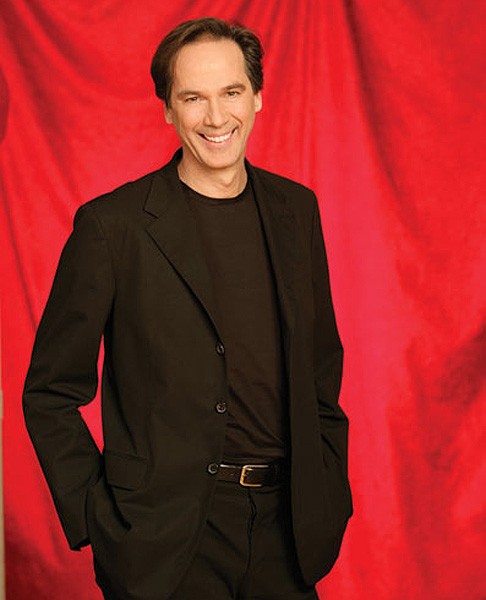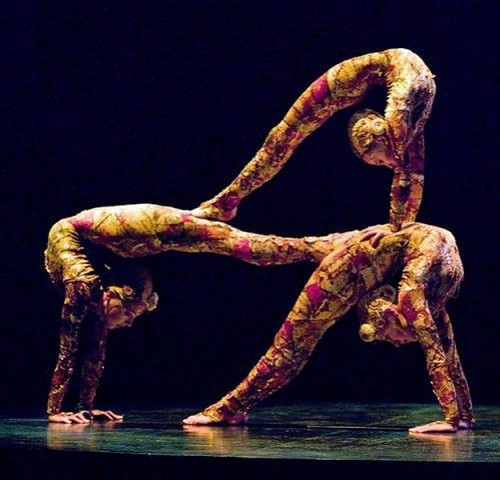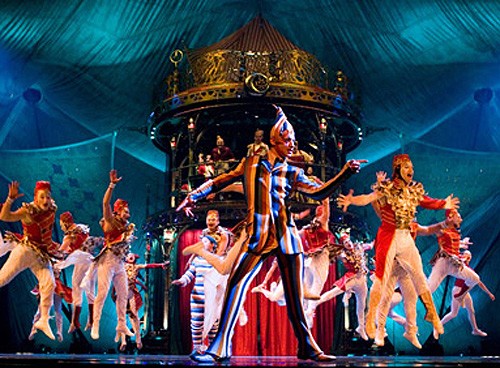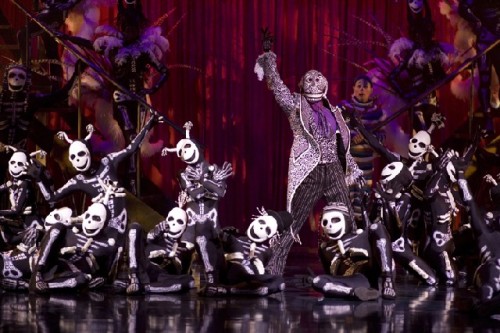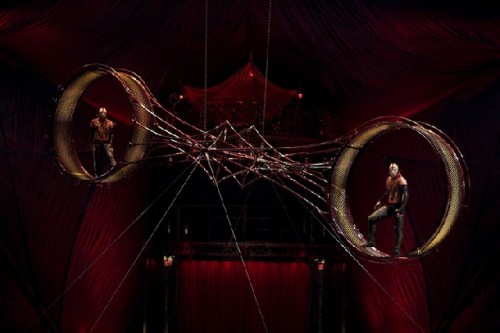Cirque du Soleil's Kooza Arrives in Boston
Their Grand Chapieau Dominates the Boston Expo Center
By: Larry Murray - Sep 08, 2008
Cirque du Soleil presents Kooza. David Shiner, Writer and Director; Serge Roy, Creation Director; Stéphane Roy, Set Designer; Marie-Chantale Vaillancourt, Costume Designer; Jean-François Côté, Composer; Clarence Ford, Choreographer; Martin Labrecque, Lighting Designer; Jonathan Deans, Co-Sound Designer; Leon Rothenberg, Co-Sound Designer; Danny Zen, Acrobatic Equipment and Rigging Designer; André Simard, Acrobatic Performance Designer: Florence Cornet, Makeup Designer; Rogé Francoeur, Props Designer.
At the Bayside Expo Center, 200 Mount Vernon Street (Columbia Point), Boston, MA 02125, through October 12. Running time 2.5 hours including one intermission.
Cirque de Soleil Home Page
From the moment you approach the colorful blue and yellow Grand Chapiteau (striped tent) erected in the middle of the parking lot at the Boston Expo Center near the JFK Library and Columbia Point, be prepared to enter a different world. Kooza's fun begins even before you dig out your tickets as buskers on stilts and musicians on platforms line the pathway leading to the tents, cheerfully welcoming you and presenting the ladies with flowers and compliments. It is the beginning of what turns out to be more than a show, it is an experience.
Whatever cares you have when you arrived don't stand a chance of surviving the onslaught of clowning and acrobatics that are the trademark of this marvelous company. As with all Cirque shows, you get hooked from the outset, with audience ice breakers that dish up laughs and surprises for twenty minutes before the official start of the main show.
In the case of Kooza it is a UPS deliveryman who carries ever larger packages into the arena looking for "Mr. Anderson" while some Keystone Cops chase what at first look like badly dressed patrons, toublemakers who are constantly creating confusion, climbing over and around audience members. In fact there were so many things going on before the show that it is impossible to watch everything at once. And that is the idea.
The secret to Cirque is that they cleverly layer their narrative so that each audience member is so busy discovering new and different aspects of the show that there is simply no time left for anything else.
Of course, when the acrobats perform, all eyes are drawn to them.
But if, by some chance, you become restless your eye can easily take in the musicians, or the nearby company members who are always engaging in little bits of business. If you are lucky enough to be seated near one of the four main tent supports you will be able to watch the swift and unobtrusive precision of the aerial riggers. Cirque honors the tradition of the three ring circus, even without the rings.
Kooza is written and directed by David Shiner, a Bostonian who began as a mime on the streets of Paris. He then became a clown, touring for 19 months with Cirque in an earlier production, Nouvelle Expérience, which then played a full year in Las Vegas. His legendary work can still be seen since the production was filmed in 1991 for HBO. With the brilliant Bill Irwin, Shiner created the Broadway show Fool Moon, an evening of what can only be described as inspired lunacy which had three separate runs between 1992 and 1999. It was there that he developed many of the routines and elements in this new Cirque show. In Fool Moon his own climbing over, under and around audience members, climbing up a rope to the box seats and being chased around the theatre by police was perfected into absolute lunacy.
Shiner explains that "Kooza is about human connections and the world of duality, good and bad," but such explanations are really not necessary. The show itself is funny, light and open when the clowns are on stage, and spellbinding when the acrobats take over. As much as Cirque tries to infuse each of its shows with metaphysical and existential meanings, all that philosophizing is just so much connective tissue to provide some order to what is in essence a variety show. People don't come away from these events thinking about the meaning of meaning, but rather savoring the daring risks these circus artists take every day. There are a hundred things that could go wrong, and yet the level of polish is so high that there is rarely a stumble.
And so much could easily go terribly wrong. Elements like the Wheel of Death which opens the second half are absolutely breathtaking. Two men run in and on the giant wheels as they spin in tandem, one even jumping rope as the device reaches unbelievable speeds. This act remains as awe inspiring as when I first saw it in Ka, which is still playing in Las Vegas. The Balancing on Chairs routine is another staple of the Cirque repertoire, and remains as suspenseful today as when this writer first saw it a decade ago in Mystère.
Kooza presents a full complement of jugglers, teeterboards, trapeze artists and unicycles. They are familiar circus acts, the sort most of us saw as children, if we were lucky. Cirque has two advantages. First because of their size, they are able to attract the finest practitioners of these skills, and then creatively raise these standard presentations to remarkable heights. In the process of creating each show, advanced acrobatic skills are a given, and it is the ability to go beyond the limitations of each speciality that makes Cirque du Soleil so special.
A good example is the aerial act. For this, the high wires are configured differently, criss-crossing the stage diagonally left to right at 15 and 25 foot heights. The four tightrope walkers add their own tension to the 6,600 pound load on each rope. The troupe ends up riding a bicycle on the high wire, with one member standing on the shoulders of another. Between this and the hyper-kinetic juggler who unleashes a dozen plates and hoops in the air at astonishing speeds that the eye can barely follow, the show is a frenzy of activity that is clearly ADD friendly.
If the blur of acrobatics on steroids doesn't impress the audience, there are also the subtler touches. Even the handmade costumes with spectacular detailing are worthy of study, and the clowns and buskers are never completely still, being choreographed to add drama as each act progresses. The icing on this layered entertainment cake are the scenic elements, mostly billowing clouds of fabric and lighting that is almost alive.
And then there is the genius of the music.
Composed by Jean-François Côté, a dozen or so members of the live band play a joyful fusion of western pop and funk with Indian Bollywood influences. The music is not just background, but a precisely choreographed sound that keeps time with the performers. It works to build tension and excitement, while underlining each of the high points of the presentations and subtly cuing the audience to applause at the "ta-da!" moments.
The costumes by Marie-Chantale Vaillancourt used a wide variety of sources of inspiration: I saw in them the paintings of Gustav Klimt, and references to Baron Münchhausen, and the Mad Max movies.
Cirque du Soleil reinvented the circus and made it both art and entertainment. From their humble roots as street performers, the original company of 20 street performers has grown into a mega Quebec organization with more than 4,000 employees, only 25% of them the performers you see on stage.
Under the leadership of Guy Laliberté, the company currently has 17 shows being presented simultaneously around the world and has generated more than 80 million paid admissions.
Note to Berkshire leaders: this is cultural tourism and development on steroids. It happens where the environment is welcoming and nurturing. Based in Montreal and helped with public funding at its outset, Cirque du Soleil hasn't received any grants from the public or private sectors since 1992. Cirque's employees and artists represent over 40 nationalities and speak 25 different languages. This year alone more than 10 million people will see one of their shows.
Cirque du Soleil has played Boston a number of times in recent years, though its original venue was Suffolk Downs. Bayside is a far superior location, especially given its ease of access via the Red Line or taxi. The tickets do not include parking which is $12.00. And it should be noted that it is set up for drivers, not for MBTA or Taxi users who must walk a very great distance to the entrance gate which is set up as far away from the MBTA station as possible. Taxis are not allowed onto the site, so if you are elderly or of limited mobility you will find the walk quite a challenge. On the other hand, Cirque does have very good handicapped access, as long as you arrive by car. Still, their blindness to those who use public transportation or taxis is an unfortunate oversight for a company that is so responsible in every other area. Or perhaps it is the Bayside management that is so inconsiderate.
Hopefully this inconvenience will be quicly forgotten once you get to the big tent.
Kooza has settled into its Boston run and has announced that they will remain through October 12. It should be on the top of everyone's list of things to do. It is a unique and enduring evening of magical entertainment.

